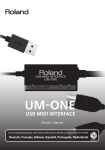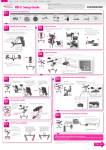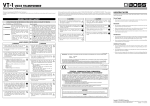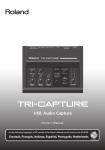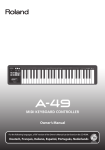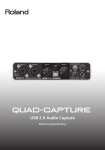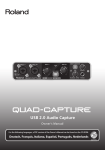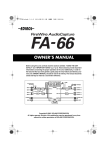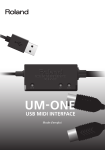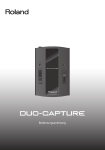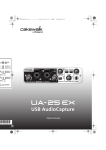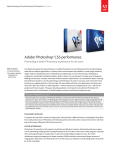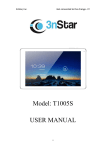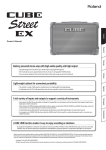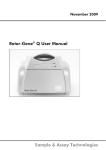Download Deutsch, Français, Italiano, Español, Português, Nederlands
Transcript
For the following languages, a PDF version of the Owner’s Manual can be found on the CD-ROM. Deutsch, Français, Italiano, Español, Português, Nederlands Before using this unit, carefully read the sections entitled: “USING THE UNIT SAFELY” and “IMPORTANT NOTES” (p. 3; p. 5). These sections provide important information concerning the proper operation of the unit. Additionally, in order to feel assured that you have gained a good grasp of every feature provided by your new unit, this Owner’s Manual should be read in its entirety. The manual should be saved and kept on hand as a convenient reference. Copyright © 2011 ROLAND CORPORATION All rights reserved. No part of this publication may be reproduced in any form without the written permission of ROLAND CORPORATION. Roland is a registered trademark of Roland Corporation in the United States and/or other countries. USING THE UNIT SAFETY About WARNING and CAUTION Notices Used for instructions intended to alert the user to the risk of death or severe injury should the unit be used improperly. Used for instructions intended to alert the user to the risk of injury or material damage should the unit be used improperly. * Material damage refers to damage or other adverse effects caused with respect to the home and all its furnishings, as well to domestic animals or pets. About the Symbols The symbol alerts the user to important instructions or warnings.The specific meaning of the symbol is determined by the design contained within the triangle. In the case of the symbol at left, it is used for general cautions, warnings, or alerts to danger. The symbol alerts the user to items that must never be carried out (are forbidden). The specific thing that must not be done is indicated by the design contained within the circle. In the case of the symbol at left, it means that the unit must never be disassembled. The symbol alerts the user to things that must be carried out. The specific thing that must be done is indicated by the design contained within the circle. In the case of the symbol at left, it means that the power-cord plug must be unplugged from the outlet. ALWAYS OBSERVE THE FOLLOWING • Do not open or perform any internal modifications on the unit. • Do not attempt to repair the unit, or replace parts within it (except when this manual provides specific instructions directing you to do so). Refer all servicing to your retailer, the nearest Roland Service Center, or an authorized Roland distributor, as listed on the “Information” page. • Never install the unit in any of the following locations. • Subject to temperature extremes (e.g., direct sunlight in an enclosed vehicle, near a heating duct, on top of heat-generating equipment); or are • Damp (e.g., baths, washrooms, on wet floors); or are • Exposed to steam or smoke; or are • Subject to salt exposure; or are • Humid; or are • Exposed to rain; or are • Dusty or sandy; or are • Subject to high levels of vibration and shakiness. • Make sure you always have the unit placed so it is level and sure to remain stable. Never place it on stands that could wobble, or on inclined surfaces. • This unit, either alone or in combination with an amplifier and headphones or speakers, may be capable of producing sound levels that could cause permanent hearing loss. Do not operate for a long period of time at a high volume level, or at a level that is uncomfortable. If you experience any hearing loss or ringing in the ears, you should immediately stop using the unit, and consult an audiologist. • Do not place containers containing liquid on this product. Never allow foreign objects (e.g., flammable objects, coins, wires) or liquids (e.g., water or juice) to enter this product. Doing so may cause short circuits, faulty operation, or other malfunctions. • Immediately disconnect the USB cable, and request servicing by your retailer, the nearest Roland Service Center, or an authorized Roland distributor, as listed on the “Information” page when: • Objects have fallen into, or liquid has been spilled onto the unit; or • If smoke or unusual odor occurs • The unit has been exposed to rain (or otherwise has become wet); or • The unit does not appear to operate normally or exhibits a marked change in performance. 3 USING THE UNIT SAFETY • In households with small children, an adult should provide supervision until the child is capable of following all the rules essential for the safe operation of the unit. • Protect the unit from strong impact. (Do not drop it!) • DO NOT play a CD-ROM disc on a conventional audio CD player. The resulting sound may be of a level that could cause permanent hearing loss. Damage to speakers or other system components may result. • Try to prevent cords and cables from becoming entangled. Also, all cords and cables should be placed so they are out of the reach of children. • Never climb on top of, nor place heavy objects on the unit. • Disconnect all cords coming from external devices before moving the unit. 4 IMPORTANT NOTES Power Supply Additional Precautions • Before connecting this unit to other devices, turn off the power to all units. This will help prevent malfunctions and/or damage to speakers or other peripheral devices. • Use a reasonable amount of care when using the unit’s buttons, sliders, or other controls; and when using its jacks and connectors. Rough handling can lead to malfunctions. Placement • Using the unit near power amplifiers (or other equipment containing large power transformers) may induce hum. To alleviate the problem, change the orientation of this unit; or move it farther away from the source of interference. • This device may interfere with radio and television reception. Do not use this device in the vicinity of such receivers. • Noise may be produced if wireless communications devices, such as cell phones, are operated in the vicinity of this unit. Such noise could occur when receiving or initiating a call, or while conversing. Should you experience such problems, you should relocate such wireless devices so they are at a greater distance from this unit, or switch them off. • Do not expose the unit to direct sunlight, place it near devices that radiate heat, leave it inside an enclosed vehicle, or otherwise subject it to temperature extremes. Excessive heat can deform or discolor the unit. • When moved from one location to another where the temperature and/or humidity is very different, water droplets (condensation) may form inside the unit. Damage or malfunction may result if you attempt to use the unit in this condition. Therefore, before using the unit, you must allow it to stand for several hours, until the condensation has completely evaporated. • Do not put anything that contains water (e.g., flower vases) on this unit. Also, avoid the use of insecticides, perfumes, alcohol, nail polish, spray cans, etc., near the unit. Swiftly wipe away any liquid that spills on the unit using a dry, soft cloth. Maintenance • For everyday cleaning wipe the unit with a soft, dry cloth or one that has been slightly dampened with water. To remove stubborn dirt, use a cloth impregnated with a mild, non-abrasive detergent. Afterwards, be sure to wipe the unit thoroughly with a soft, dry cloth. • Never use benzine, thinners, alcohol or solvents of any kind, to avoid the possibility of discoloration and/or deformation. • When connecting / disconnecting all cables, grasp the connector itself—never pull on the cable. This way you will avoid causing shorts, or damage to the cable’s internal elements. • To avoid disturbing your neighbors, try to keep the unit’s volume at reasonable levels. You may prefer to use headphones, so you do not need to be concerned about those around you. • When you need to transport the unit, package it in the box (including padding) that it came in, if possible. Otherwise, you will need to use equivalent packaging materials. • Some connection cables contain resistors. Do not use cables that incorporate resistors for connecting to this unit. The use of such cables can cause the sound level to be extremely low, or impossible to hear. For information on cable specifications, contact the manufacturer of the cable. Handling CDs • Avoid touching or scratching the shiny underside (encoded surface) of the disc. Damaged or dirty CD discs may not be read properly. Keep your discs clean using a commercially available CD cleaner. * Microsoft, Windows and Windows Vista are either registered trademarks or trademarks of Microsoft Corporation. * The screen shots in this document are used in compliance with the guidelines of the Microsoft Corporation. * Windows® is known officially as: “Microsoft® Windows® operating system.” * Apple, Macintosh and Mac OS are either registered trademarks or trademarks of Apple Inc. * Cakewalk is a registered trademark of Cakewalk, Inc. in the United States. * ASIO is a trademark of Steinberg Media Technologies GmbH. * Company names and product names appearing in this document are registered trademarks or trademarks of their respective owners. * MMP (Moore Microprocessor Portfolio) refers to a patent portfolio concerned with microprocessor architecture, which was developed by Technology Properties Limited (TPL). Roland has licensed this technology from the TPL Group. 5 Contents USING THE UNIT SAFETY. . . . . . . . . . . . . . . . . . . . . . . . . . . . . . . . . . . . . . . . . . . . . . . . . . . 3 IMPORTANT NOTES. . . . . . . . . . . . . . . . . . . . . . . . . . . . . . . . . . . . . . . . . . . . . . . . . . . . . . . . 5 Panel Descriptions. . . . . . . . . . . . . . . . . . . . . . . . . . . . . . . . . . . . . . . . . . . . . . . . . . . . . . . . . 7 Top Panel, Bottom Panel. . . . . . . . . . . . . . . . . . . . . . . . . . . . . . . . . . . . . . . . . . . . . . . . . . . . . . . . . . . . . . . . . . . . . . . . 7 Front Panel, Rear Panel. . . . . . . . . . . . . . . . . . . . . . . . . . . . . . . . . . . . . . . . . . . . . . . . . . . . . . . . . . . . . . . . . . . . . . . . . 8 Driver Installation . . . . . . . . . . . . . . . . . . . . . . . . . . . . . . . . . . . . . . . . . . . . . . . . . . . . . . . . . 9 Confirm that Sound can be Heard. . . . . . . . . . . . . . . . . . . . . . . . . . . . . . . . . . . . . . . . . . . . . . . . . . . . . . . . . . . . . . 14 Basic Use. . . . . . . . . . . . . . . . . . . . . . . . . . . . . . . . . . . . . . . . . . . . . . . . . . . . . . . . . . . . . . . . . 15 Playing Back Audio. . . . . . . . . . . . . . . . . . . . . . . . . . . . . . . . . . . . . . . . . . . . . . . . . . . . . . . . . . . . . . . . . . . . . . . . . . . . 15 Recording Audio. . . . . . . . . . . . . . . . . . . . . . . . . . . . . . . . . . . . . . . . . . . . . . . . . . . . . . . . . . . . . . . . . . . . . . . . . . . . . . 16 Connecting the External Equipment to DUO-CAPTURE. . . . . . . . . . . . . . . . . . . . . . . . . . . . . . . . . . . . . . . . . 17 Using the DUO-CAPTURE with a Computer. . . . . . . . . . . . . . . . . . . . . . . . . . . . . . . . . . . . . . . . . . . . . . . 17 Using the DUO-CAPTURE with an iPad. . . . . . . . . . . . . . . . . . . . . . . . . . . . . . . . . . . . . . . . . . . . . . . . . . . 17 Troubleshooting. . . . . . . . . . . . . . . . . . . . . . . . . . . . . . . . . . . . . . . . . . . . . . . . . . . . . . . . . . 19 Driver Installation. . . . . . . . . . . . . . . . . . . . . . . . . . . . . . . . . . . . . . . . . . . . . . . . . . . . . . . . . . . . . . . . . . . . . . . . . . . . . 19 Using the DUO-CAPTURE. . . . . . . . . . . . . . . . . . . . . . . . . . . . . . . . . . . . . . . . . . . . . . . . . . . . . . . . . . . . . . . . . . . . . . 20 Changing Computer Settings to Avoid Problems. . . . . . . . . . . . . . . . . . . . . . . . . . . . . . . . . . . . . . . . . . . . . . . 24 Driver Signing Options Setting (Windows XP). . . . . . . . . . . . . . . . . . . . . . . . . . . . . . . . . . . . . . . . . . . . 24 Power Management Settings. . . . . . . . . . . . . . . . . . . . . . . . . . . . . . . . . . . . . . . . . . . . . . . . . . . . . . . . . . . . 24 System “Performance” Settings (Windows) . . . . . . . . . . . . . . . . . . . . . . . . . . . . . . . . . . . . . . . . . . . . . . . 25 Setting the System Volume. . . . . . . . . . . . . . . . . . . . . . . . . . . . . . . . . . . . . . . . . . . . . . . . . . . . . . . . . . . . . . 27 Voice Communication Software Settings (Windows 8/Windows 7). . . . . . . . . . . . . . . . . . . . . . . . 28 Monitoring Function Settings (Windows 8/Windows 7). . . . . . . . . . . . . . . . . . . . . . . . . . . . . . . . . . . 28 Reinstalling the Driver. . . . . . . . . . . . . . . . . . . . . . . . . . . . . . . . . . . . . . . . . . . . . . . . . . . . . . . . . . . . . . . . . . . . . . . . . 29 Deleting the Driver. . . . . . . . . . . . . . . . . . . . . . . . . . . . . . . . . . . . . . . . . . . . . . . . . . . . . . . . . . . . . . . . . . . . . . 29 Advanced Driver Settings. . . . . . . . . . . . . . . . . . . . . . . . . . . . . . . . . . . . . . . . . . . . . . . . . . . . . . . . . . . . . . . . . . . . . . 30 6 Main Specifications. . . . . . . . . . . . . . . . . . . . . . . . . . . . . . . . . . . . . . . . . . . . . . . . . . . . . . . 33 Block Diagram. . . . . . . . . . . . . . . . . . . . . . . . . . . . . . . . . . . . . . . . . . . . . . . . . . . . . . . . . . . . 33 Panel Descriptions Top Panel, Bottom Panel 2 1 No. 4 5 3 Name Description PEAK indicator Blinks in time with the audio signal that is input via the LINE IN jack or MIC/ GUITAR jack. [INPUT VOLUME] slider Adjusts the volume of the audio signal that is input via the LINE IN jack or MIC/GUITAR jack. 2 USB indicator Lights when the DUO-CAPTURE is connected to a computer and the computer has detected the DUO-CAPTURE. 3 [OUTPUT VOLUME] slider 1 4 5 [SAMPLE RATE] switch [EXT] switch Adjusts the volume of the audio signal that is output to the PHONES jack. 44.1k: The DUO-CAPTURE will record and play back at a sample rate of 44.1 kHz. 48k: The DUO-CAPTURE will record and play back at a sample rate of 48 kHz. TAB: For connecting an iPad. Refer to “Using the DUO-CAPTURE with an iPad” (p. 17). Driver installation is not necessary. COMPUTER: For connecting a computer. Refer to “Using the DUO-CAPTURE with a Computer” (p. 17). You must install the driver in your computer. 7 Panel Descriptions Front Panel, Rear Panel 6 No. 7 9 8 Name Description LINE IN jack Used to connect the audio device that will send audio signals to the DUOCAPTURE. Use the [INPUT VOLUME] slider to adjust the volume (*1). MIC/GUITAR jack Used to connect a guitar or monaural dynamic microphone. Use the [INPUT VOLUME] slider to adjust the volume (*1). 7 PHONES jack Used to connect headphones. Use the [OUTPUT VOLUME] slider to adjust the volume. The stereo miniature phone-type jack on the right can be used as a LINE OUT jack. 8 USB connector 6 Used to connect the DUO-CAPTURE to a USB cable. Determines whether the received audio signal is output directly to the PHONES jack. LINE IN MIC/ GUITAR [INPUT MONITOR] button PHONES + OFF AUTO ON + ASIO-compatible software [INPUT MONITOR] button 9 ON: The input audio signal is output directly. OFF (AUTO): The input audio signal is not output directly. Note that when ASIO-compatible software is used, the input audio signal may be output directly according to the ASIO Direct Monitor setting. Changes the impedance of the MIC/GUITAR jack (p. 16). [Hi-Z] button ON: OFF: Select “ON” when a guitar is connected. Select “OFF” when a dynamic microphone is connected. Changes the input gain of the LINE IN jack and the MIC/GUITAR jack (p. 16). [INPUT GAIN] button HI: LO: Select “Hi” to increase input gain, such as when a dynamic microphone is connected. Select “Lo” when an audio device is connected to the LINE IN jack or when a guitar is connected. (*1): We recommend using one input jack (i.e., either the LINE jack or the MIC/GUITAR jack) at a time. If devices are connected to both jacks at the same time, the sound input via both jacks is mixed together, but the DUO-CAPTURE cannot adjust the balance of the mix. 8 Driver Installation Windows Mac OS X Note Do not connect the DUO-CAPTURE to the computer until you are directed to do so. A “driver” is software that transfers data between the DUO-CAPTURE and application software running on your computer, when your computer and the DUO-CAPTURE are connected. 1. Start up the computer without the DUO-CAPTURE connected. Disconnect all USB cables other than those for a USB keyboard and/or USB mouse (if used). Windows Log on to the computer with a user account that has administrator privileges. Windows 8 Switch to the “Desktop.” 2. Exit all applications that are running. 3. Insert the included CD-ROM into the CD-ROM drive. 4. Double-click the following file on the included CD-ROM and start the installer. Operating System File Windows [Setup] in the [Driver] folder Mac OS X [DuoCapture_USBDriver] in the [Driver] folder Refer to the Roland website for the latest USB drivers and information about compatibility with the latest operating system versions. http://www.roland.com/ Windows users: continue from p. 10 Mac OS X users: continue from p. 13 9 Driver Installation Windows 5. When a confirmation screen regarding user account control appears, click [Yes] or [Continue]. 6. When “The DUO-CAPTURE Driver will be installed on your computer.” appears, click [Next]. 7. Click [Next] again. Windows 8/Windows 7/Windows Vista If a dialog box regarding Windows security appears, click [Install]. Windows XP If the “Software Install” dialog box appears, click [Continue] to proceed with the installation. If you cannot proceed, click [OK] to cancel the installation. Change the settings as described in “Driver Signing Options Setting (Windows XP)” (p. 24) and try installing again. 8. When “Ready to install the driver.” appears, connect the DUO-CAPTURE to the computer using a USB cable. * Turn down the volume on any peripheral devices before connecting the USB cable. It may take several minutes for the driver to be installed. Windows 8/Windows 7/Windows Vista If other messages appear, follow the instructions on the screen. The driver will be installed automatically. Windows XP “Found new hardware” will appear in the lower-right corner of the screen. Windows 8/Windows 7/Windows Vista users: continue from p. 11 Windows XP users: continue from p. 12 10 Driver Installation Windows 8/Windows 7/Windows Vista 9. When “Installation has been completed.” appears, click [Close]. Close the "DUO-CAPTURE Driver Setup" dialog box. 10. Open the “Control Panel,” click [Hardware and Sound], and then click [Sound]. If you have selected Icon view or Classic view, double-click [Sound]. 11. Click the [Playback] tab, select the DUO-CAPTURE’s [OUT], and then click [Set Default]. Proceed to p. 14 12. Click [OK]. If you cannot select the DUO-CAPTURE, refer to “Using the DUO-CAPTURE” (p. 20). If the DUO-CAPTURE is selected as the output device, the computer’s audio alerts will be played using the DUO-CAPTURE; they will not be heard from the computer’s speakers. To open the Control Panel Windows 8 1. On the Start screen, click the Desktop. 2. Move the mouse pointer to the upper right or lower right corner of the screen to display the charms. * On touch-enabled PCs, swipe from the right side of the screen to display the charms. 3. Click [Settings] and display the “Settings charms.” 4. In “Settings charms,” click [Control Panel] to open the “Control Panel.” 11 Driver Installation Windows XP 9. If a dialog box that asks whether you want to connect to Windows Update appears, select [No, not this time] and click [Next]. 10. Select [Install the software automatically (Recommended)] and click [Next]. 11. If the “Hardware Installation” dialog box appears, click [Continue Anyway] to proceed with the installation. 12. When “Completing the Found New Hardware Wizard” appears, click [Finish]. 13. When “Installation has been completed.” appears, click [Close] to close the “DUO-CAPTURE Driver Setup” dialog box. If the “Change System Settings” dialog box appears, click [Yes] to restart Windows. 14. Open the “Control Panel,” click [Sounds, Speech, and Audio Devices], and then click [Sounds and Audio Devices]. If you have selected Classic view, double-click [Sounds and Audio Devices]. 15. Click the [Audio] tab and select [OUT (DUO-CAPTURE)] in the [Sound playback] area. 16. Click [OK]. Proceed to p. 14 If you cannot select the DUO-CAPTURE, refer to “Using the DUO-CAPTURE” (p. 20). If the DUO-CAPTURE is selected as the output device, the computer’s audio alerts will be played using the DUO-CAPTURE; they will not be heard from the computer’s speakers. 12 Driver Installation Mac OS X If a dialog box requesting a password appears during installation, enter a computer administrator’s user name and password and click the [Install Software] button or [OK] button. 5. When “Welcome to the DUO-CAPTURE Driver installer” appears, click [Continue]. 6. If the screen for selecting the installation destination appears, select the startup disk and click [Continue]. 7. When the installation type appears, click [Install] or [Upgrade]. 8. Click [Continue Installation] in the next screen. 9. When the installation has finished, click [Restart] to restart the computer. It may take some time for the computer to restart. 10. After the computer restarts, connect the DUO-CAPTURE to the computer using a USB cable. * Turn down the volume on any peripheral devices before connecting the USB cable. 11. Open “System Preferences” and click [Sound]. 12. Click the [Output] tab and select [DUO-CAPTURE 44.1kHz]. “44.1kHz” is displayed after the product name when the sample rate switch on the DUO-CAPTURE is set to “44.1kHz.” 13. When you have finished making these settings, quit “System Preferences.” Proceed to p. 14 If you cannot select the DUO-CAPTURE, refer to “Using the DUO-CAPTURE” (p. 20). If the DUO-CAPTURE is selected as the output device, the computer’s audio alerts will be played using the DUO-CAPTURE; they will not be heard from the computer’s speakers. 13 Driver Installation Confirm that Sound can be Heard Windows Mac OS X 1. Connect the headphones or speakers as shown in the figure. * To prevent malfunction and/or damage to speakers or other devices, always turn down the volume, and turn off the power on all devices before making any connections. 2. Open the folder named [Sample] on the included CD-ROM, and copy the file “TTears” (.mp3) to the desktop. 3. Double-click the file “TTears” (.mp3) that you copied to the desktop. Windows Windows Media Player starts. Mac OS X iTunes starts. Click the playback button to play the sample file. The software that starts and is used to play the sample file may vary depending on your computer environment. If different software starts, play the sample file as described in the owner’s manual for the software you are using. 4. Adjust the volume. Use the DUO-CAPTURE’s [OUTPUT VOLUME] slider to adjust the volume. If the sample file can be heard, the computer and DUO-CAPTURE are connected properly and the driver has been successfully installed. If you cannot hear the sample file, refer to “Using the DUO-CAPTURE” (p. 20). * Use of the demo song supplied with this product for any purpose other than private, personal enjoyment without the permission of the copyright holder is prohibited by law. Additionally, this data must not be copied, nor used in a secondary copyrighted work without the permission of the copyright holder. 14 Basic Use Precautions Concerning the Use of Software Before using the DUO-CAPTURE with your software, please note the following points. • Connect the DUO-CAPTURE to the computer before starting the software. • Do not disconnect the DUO-CAPTURE from the computer while the software is running. After exiting the software, disconnect the DUO-CAPTURE. • Select the DUO-CAPTURE for the software’s audio device setting. • The DUO-CAPTURE will not operate in the Mac OS X Classic environment. Use the DUOCAPTURE when the Classic environment is not running. Playing Back Audio Set to match the software’s sample rate setting DUO-CAPTURE bottom panel DUO-CAPTURE rear panel Software’s Audio Output Device: DUO-CAPTURE Front panel 15 Basic Use Recording Audio Set to match the software’s sample rate setting DUO-CAPTURE bottom panel Software’s Audio Input Device: DUO-CAPTURE or Cassette deck Turntable * We recommend using one input jack (i.e., either the LINE jack or the MIC/GUITAR jack) at a time. If devices are connected to both jacks at the same time, the sound input via both jacks is mixed together, but the DUO-CAPTURE cannot adjust the balance of the mix. Set the [Hi-Z] button and the [INPUT GAIN] button as described below depending on the audio device that is connected. Device [Hi-Z] button [INPUT GAIN] button Microphone OFF HI Guitar ON LO Cassette deck Turntable — (Either ON or OFF is acceptable) LO Note When recording a musical instrument such as a guitar, we recommend turning on the input monitor (p. 8). You can listen to the instrument’s output directly without passing the audio signal through the computer. When the input monitor is turned off, the instrument’s audio signal passes through the computer, therefore the sound may be delayed. If sound is doubled when the [INPUT MONITOR] button is set to “ON,” set the [INPUT MONITOR] button to “OFF (AUTO).” * Howling could be produced depending on the location of microphones relative to speakers. This can be remedied by: 1. Changing the orientation of the microphone(s). 2. Relocating microphone(s) at a greater distance from speakers. 3. Lowering volume levels. 16 Basic Use Connecting the External Equipment to DUO-CAPTURE The [COMPUTER/TAB] switch located on the bottom panel needs to be placed at the setting that’s appropriate for the device to which you’re connecting the DUO-CAPTURE. Switch position Connected device TAB For connecting an iPad. Refer to “Using the DUO-CAPTURE with an iPad” (p. 17). Driver installation is not necessary. COMPUTER For connecting a computer. Refer to “Using the DUOCAPTURE with a Computer” (p. 17). You must install the driver in your computer. Using the DUO-CAPTURE with a Computer Rear panel 2 1 Bottom panel 1. Set the DUO-CAPTURE’s [COMPUTER/TAB] switch to the “COMPUTER” position. 2. Connect the DUO-CAPTURE to the computer. MEMO If you want to connect the DUO-CAPTURE to a computer in which the USB driver has not been installed, disconnect the DUO-CAPTURE’s USB cable from the computer, and install the USB driver in the computer as described in the section “Driver Installation” in the DUO-CAPTURE owner’s manual. Using the DUO-CAPTURE with an iPad Before you continue, please make sure to access the following URL and check the operating requirements and other relevant information. http://www.roland.com/support/ 17 Basic Use NOTE • The first-generation iPad cannot be used. • The iPad app you’re using must support CoreAUDIO. You’ll need to provide the following items • iPad (made by the Apple Inc.) • Apple iPad Camera Connection Kit (Camera Connector; made by the Apple Inc.) • USB hub (commercially available; a type to which an AC adaptor or other power supply is connected) •USB cable (commercially available) 1 2 AC adaptor included with the USB hub USB hub that works with a connected power supply (commercially available) Apple iPad Camera Connection Kit (Camera Connector) Rear panel 4 3 Bottom panel 1. Power up your USB hub (connect the AC adaptor to the USB hub). 2. Connect the USB hub to the iPad using the Camera Connector of the Apple iPad Camera Connection Kit. 3. Set the DUO-CAPTURE’s [COMPUTER/TAB] switch to the “TAB” position. 4. Connect the DUO-CAPTURE to the USB hub. MEMO Operation may be unstable if you use a USB hub of a type that does not have a connected power supply, or if you connect the DUO-CAPTURE directly to the iPad. 18 Troubleshooting If you experience problems, read this chapter first. It contains tips for solving most problems. If this chapter cannot help you solve a problem, please refer to the support section of our website. If the problem is not resolved, refer to the contact information listed at the end of this document. Roland website: http://www.roland.com/ Driver Installation Problem Confirmation Resolution Installer does not start Are you attempting to install from a networked CD-ROM drive? You cannot install from a networked CD-ROM drive. Are you logged on with a user account that does not have administrator privileges? Cannot install Warning or error appears during installation (Windows) Installer does not exit “Found New Hardware Wizard” appears again after driver was installed (Windows XP) Log on to the computer with a user account that has administrator privileges. For details, consult the administrator for your computer system. Is the “Driver Signing Options” setting set to [Block]? (Windows XP) Change the “Driver Signing Options” setting (p. 24). Are other programs or resident programs (such as antivirus programs) running? Be sure to exit all other programs before installation. In the “Device Manager,” do you see “Other device,” “Unknown device,” or a device for which “?,” “!,” or “x” is displayed? Reinstall the DUO-CAPTURE driver (p. 29). Is your computer running on battery power? Connect the power cord to the computer. Other than a mouse and keyboard, are any USB devices connected? Make sure that there are no USB devices connected to the computer (other than a mouse and keyboard) during installation. Is the DUO-CAPTURE connected to a USB hub that is connected to a power supply? Use a USB hub that connects to a power supply. Did you connect the DUO-CAPTURE to a different USB connector than the one you used when installing the driver? If you change the USB connector to which the DUO-CAPTURE is connected, the “Found New Hardware Wizard” may appear again even if the driver has already been installed on the computer. Follow step 9 of the driver installation procedure (p. 12) and install the driver. 19 Troubleshooting Problem Numeral such as “2-” appears at beginning of device name (Windows) Confirmation Did you connect the DUO-CAPTURE to a different USB connector than the one you used when installing the driver? Resolution If you connect the DUO-CAPTURE to a different USB connector than the one you used when installing the driver, a numeral may appear with the device name. To have the device name appear without the numeral, connect the DUO-CAPTURE to the same USB connector used during installation, or reinstall the driver (p. 29). Using the DUO-CAPTURE Problem Confirmation Resolution Is the driver installed? Install the driver (p. 9). Is the DUO-CAPTURE’s USB indicator off? Is the DUO-CAPTURE’s device name displayed? Cannot select or use DUO-CAPTURE device Did the computer enter standby (suspend) mode, hibernate mode, or sleep mode while the DUO-CAPTURE was connected? Did you disconnect and reconnect the USB cable while using the DUOCAPTURE? Was the DUO-CAPTURE connected to the computer while the computer was starting up? Cannot change driver settings (Windows 8/ Windows 7) 20 Is the monitoring function of Windows turned on? Make sure that the DUO-CAPTURE is connected to the computer correctly. If the problem is not resolved, reinstall the driver (p. 29). Exit all programs that are using the DUO-CAPTURE, disconnect the DUO-CAPTURE’s USB cable, and then reconnect it. If the problem is not resolved, reinstall the driver (p. 29). Exit all programs that are using the DUO-CAPTURE, disconnect the DUO-CAPTURE’s USB cable, and then reconnect it. If the problem is not resolved, restart the computer. Exit all programs that are using the DUO-CAPTURE, disconnect the DUO-CAPTURE’s USB cable, and then reconnect it. If the problem is not resolved, restart the computer. Connect the DUO-CAPTURE after the computer has started up. (With some computers, the DUO-CAPTURE cannot be used if it is connected to the computer while the computer is starting up.) Turn off the monitoring function (p. 28). Troubleshooting Problem Confirmation Resolution Is the driver installed? Install the driver (p. 9). Are the software’s input device and output device configured? Select the DUO-CAPTURE as the input and output device (p. 15, p. 16). Is the DUO-CAPTURE’s USB indicator off? Is another program using the DUOCAPTURE? Cannot play back or record Did the computer enter standby (suspend) mode, hibernate mode, or sleep mode while the DUO-CAPTURE was connected? Did you disconnect and reconnect the USB cable while using the DUOCAPTURE? Make sure that the DUO-CAPTURE is connected to the computer correctly. If the problem is not resolved, reinstall the driver (p. 29). Exit all programs that are using the DUO-CAPTURE, disconnect the DUO-CAPTURE’s USB cable, and then reconnect it. If the problem is not resolved, reinstall the driver (p. 29). Exit all programs that are using the DUO-CAPTURE, disconnect the DUO-CAPTURE’s USB cable, and then reconnect it. If the problem is not resolved, restart the computer. Exit all programs that are using the DUO-CAPTURE, disconnect the DUO-CAPTURE’s USB cable, and then reconnect it. If the problem is not resolved, restart the computer. Make sure that the software’s audio sample rate setting matches the DUO-CAPTURE’s sample rate setting. Is the sample rate setting correct? After changing the DUO-CAPTURE’s sample rate, exit all programs that are using the DUO-CAPTURE, disconnect the DUO-CAPTURE’s USB cable, and then reconnect it. Is the computer’s volume setting turned down? Adjust the computer’s volume setting (p. 27). Are you using voice communication software? (Windows 8/Windows 7) Disable automatic volume adjustment (p. 28). 21 Troubleshooting Problem Confirmation Was the DUO-CAPTURE connected to the computer while the computer was starting up? Cannot play back or record Did the computer perform a processorintensive task while you were using the DUO-CAPTURE? No sound from computer’s speakers This is not a malfunction. Resolution Connect the DUO-CAPTURE after the computer has started up. (With some computers, the DUO-CAPTURE cannot be used if it is connected to the computer while the computer is starting up.) Stop playback or recording, and then try playing back or recording again. If the problem is not resolved, exit all programs that are using the DUO-CAPTURE, disconnect the DUO-CAPTURE’s USB cable, and then reconnect it. When using the DUO-CAPTURE, no sound is heard from the computer’s speakers. Connect headphones to the DUO-CAPTURE. Make sure that the digital device’s audio sample rate setting matches the DUO-CAPTURE’s sample rate setting. Cannot play audio using digital connection Is the sample rate setting correct? Noise heard when playing guitar Does the noise decrease when the guitar’s volume is turned down? Move away from the computer. Is the input level raised? Use the [INPUT VOLUME] slider to increase the input level. If your software has an input level adjustment, check the input level setting. Is the [Hi-Z] switch set to “OFF”? When recording a microphone connected to the MIC/GUITAR jack, set the [Hi-Z] switch to “OFF.” Is the [Hi-Z] switch set to “ON”? When recording a guitar connected to the MIC/ GUITAR jack, set the [Hi-Z] switch to “ON.” Are you using a cable with a built-in resistor? When connection cables with resistors are used, the volume level of equipment connected to the inputs (LINE IN, MIC/GUITAR) may be low. If this happens, use connection cables that do not contain resistors. Does the sensitivity of the microphone match the input level of the DUOCAPTURE? The DUO-CAPTURE’s microphone input level is -45 dBu. If the sensitivity of the microphone is low, the sound will be quiet. Recorded sound is too quiet 22 After changing the DUO-CAPTURE’s sample rate, exit all programs that are using the DUO-CAPTURE, disconnect the DUO-CAPTURE’s USB cable, and then reconnect it. Troubleshooting Problem Confirmation Resolution Recorded sound is too loud Is the input level too high? Use the [INPUT VOLUME] slider to decrease the input level. If your software has an input level adjustment, check the input level setting. Are multiple programs running? Exit programs that are not in use. Did you adjust the software’s audio buffer size? If the software allows you to adjust the audio buffer size, change the buffer size. Did you adjust the driver’s audio buffer size? Change the driver’s audio buffer size setting (p. 30). Have you adjusted the “Recording Margin” setting? (Mac OS X) If audio drops out or if noise is heard even if you have adjusted the audio buffer size, increase the “Recording Margin” setting (p. 32). Is the system software up to date? Run Windows Update or Microsoft Update and make sure the system software is up to date. Have you used Mac OS X Software Update? Run Software Update and make sure the system software is up to date. Are the drivers for the computer’s internal chipset and graphics card up to date? Update to the latest drivers. Sound is interrupted during playback or recording, sound drops out Are the drivers for the computer’s LAN hardware (wired and wireless) up to date? Install the latest LAN hardware drivers. If the problem is not resolved, disable the LAN. Is the computer’s power management setting set to economy mode? Configure power management settings (p. 24). Is the DUO-CAPTURE connected to a USB hub? Connect the DUO-CAPTURE directly to one of the computer’s USB connectors. Is the monitoring function of Windows turned on? (Windows 8/Windows 7) Turn off the monitoring function (p. 28). Did you try to play back or record immediately after the computer started up or after waking up from sleep mode? Wait and try playing back or recording later. 23 Troubleshooting Changing Computer Settings to Avoid Problems Changing these computer settings can help you avoid the problems described in “Driver Installation” (p. 19) and “Using the DUO-CAPTURE” (p. 20). Driver Signing Options Setting (Windows XP) If the “Driver Signing Options” setting is set to [Block], you cannot install the driver. Configure as follows. 1. Open the “Control Panel,” click [Performance and Maintenance], and then click the [System] icon. If you have selected Classic view, double-click [System]. 2. Click the [Hardware] tab, and then click [Driver Signing]. The “Driver Signing Options” dialog box will open. 3. In the “Driver Signing Options” dialog box, select [Warn] or [Ignore], and then click [OK]. 4. Click [OK] to close the “System Properties” dialog box. 5. Install the driver as described in “Driver Installation” (p. 9). When you have completed the installation, return the “Driver Signing Options” setting to its original setting. Power Management Settings If the sound is interrupted during a performance or if sounds are missing, you may be able to resolve the problem by changing the computer’s power management settings. Windows 8/Windows 7/Windows Vista 1. Open the “Control Panel,” click [System and Security] or [System and Maintenance], and then click [Power Options]. • If you have selected Icon view in Windows 8/Windows 7, double-click the [Power Options] icon. • If you have selected Classic view in Windows Vista, double-click the [Power Options] icon. 2. When “Select a power plan” appears, select [High performance]. 3. Click [Change plan settings] next to “High performance.” If “High performance” is not displayed in Windows 8/Windows 7, click [Show additional plans]. 24 Troubleshooting 4. Click [Change settings that are currently unavailable]. 5. In the [Advanced settings] tab of the “Power Options” control panel, click the [+] mark next to “Hard disk,” and then click the [+] mark next to “Turn off hard disk after.” 6. Click [Setting], click the down arrow, and then select [Never]. 7. Click [OK] to close the “Power Options” window. 8. Close the “Edit plan settings” screen. Windows XP 1. Open the “Control Panel,” click [Performance and Maintenance], and then click [Power Options]. If you have selected Classic view, double-click [Power Options]. 2. Click the [Power Schemes] tab, and set the “Power schemes” to [Always On]. 3. Click [OK] to close the “Power Options Properties” window. Mac OS X This setting is not available on certain versions of Mac OS X. 1. Open “System Preferences” and click [Energy Saver]. 2. Click [Options]. 3. Set “Processor Performance” to [Highest]. System “Performance” Settings (Windows) You may be able to solve the problem by changing the “Performance” setting of the system as described below. 1. Windows 8/Windows 7 Open the “Control Panel,” click [System and Security], and click [System]. If you have selected Icon view double-click the [System] icon. 2. At the left, click [Advanced system settings]. 25 Troubleshooting 3. A User Account Control dialog box will appear; click [Yes]. If you’re asked to enter an administrator password, log on to the computer with a user account that has administrator privileges, and make the setting again. 4. Click “Performance” [Settings], and click the [Advanced] tab. 5. Choose [Background services] and click [OK]. 6. Click [OK] to close “System Properties.” Windows Vista 1. Open the “Control Panel,” click [System and Maintenance], and click [System]. If you have selected Classic view, double-click the [System] icon. 2. In the list of “tasks” shown at the left, click [Advanced System Settings]. 3. A User Account Control dialog box will appear; click [Continue]. If you’re asked to enter an administrator password, log on to the computer with a user account that has administrator privileges, and make the setting again. 4. Click “Performance” [Settings], and click the [Advanced] tab. 5. Choose [Background services] and click [OK]. 6. Click [OK] to close System Properties. Windows XP 1. Open the “Control Panel,” click [Performance and Maintenance], and click [System]. If you have selected Classic view, double-click the [System] icon. 2. Click the [Advanced] tab, and click “Performance” [Settings]. 3. Click the [Advanced] tab. 4. Choose [Background services], and click [OK]. 5. Click [OK] to close “System Properties.” 26 Troubleshooting Setting the System Volume If the playback volume is too loud or too quiet, try adjusting the system volume. Windows 8/Windows 7 1. Open the “Control Panel” and set the display mode to “Category.” 2. Click the [Hardware and Sound] tab, and then click [Adjust system volume]. 3. After the volume mixer appears, select the DUO-CAPTURE’s [OUT] from the “Device” pull-down menu and adjust the volume. Windows Vista 1. Open the “Control Panel” and click [Hardware and Sound]. If you have selected Classic view, click [Control Panel Home] to exit Classic view. 2. Click [Adjust system volume] in “Sound.” 3. After the volume mixer appears, select the DUO-CAPTURE’s [OUT] from the “Device” menu and adjust the volume. If the [Mute] button is set to “On,” click the [Mute] button to set it to “Off.” Windows XP 1. Open the “Control Panel,” click [Sounds, Speech, and Audio Devices], and then click [Sounds and Audio Devices]. If you have selected Classic view, double-click [Sounds and Audio Devices]. 2. Click the [Audio] tab. 3. In the “Sound playback” area, make sure that [OUT (DUO-CAPTURE)] is selected as the “Default device,” and click [Volume]. 4. When the volume control appears, adjust the “Wave” volume. If the mute check box is selected, clear the check box. Mac OS X 1. Open “System Preferences” and click [Sound]. 2. Click the [Output] tab. 3. In the “Select a device for sound output” area, make sure that [DUO-CAPTURE] is selected and use the “Output volume” slider to adjust the volume. If the mute check box is selected, clear the check box. 27 Troubleshooting Voice Communication Software Settings (Windows 8/Windows 7) If you are using voice communication software, the volume of the audio device may be adjusted automatically to suit the characteristics of the conversation. Use the following procedure to disable automatic volume adjustment. 1. Open the “Control Panel,” click [Hardware and Sound], and then click [Sound]. If you have selected Icon view, click [Sound]. 2. In the [Communications] tab, set “When Windows detects communications activity” to [Do nothing]. 3. Click [OK] to close the “Sound” window. Monitoring Function Settings (Windows 8/Windows 7) If the monitoring function of Windows is enabled, the input sound may be doubled (each sound is repeated) or feedback may be heard. Use the following procedure to disable the monitoring function of Windows. 1. Open the “Control Panel,” click [Hardware and Sound], and then click [Sound]. If you have selected Icon view, click [Sound]. 2. In the “Recording” area, click the DUO-CAPTURE’s [IN], and then click [Properties]. 3. Open the “Listen” tab and clear the [Listen to this device] check box. 4. Click [OK] to close the “Properties” window. 5. Click [OK] to close the “Sound” window. 28 Troubleshooting Reinstalling the Driver If you experience problems installing the driver, use the following procedure and reinstall the driver. 1. Delete the DUO-CAPTURE’s driver. 2. Install the driver again as described in “Driver Installation” (p. 9). Deleting the Driver If the computer does not detect the DUO-CAPTURE correctly, use the following procedure to delete the driver, and then install the driver again as described in “Driver Installation” (p. 9). Windows 1. Start up the computer without the DUO-CAPTURE connected. Disconnect all USB cables other than those for a USB keyboard and/or USB mouse (if used). 2. Log on to the computer with a user account that has administrator privileges. 3. Insert the included CD-ROM into the computer’s CD-ROM drive. 4. Double-click the [Uninstal] icon in [Driver] folder on the included CD-ROM. 5. When a confirmation screen regarding user account control appears, click [Yes] or [Continue]. 6. When “The installed DUO-CAPTURE driver will be uninstalled.” appears, click [OK]. If other messages appear, follow the instructions on the screen. 7. When “Uninstallation was completed.” appears, click [OK] and restart the computer. 29 Troubleshooting Mac OS X 1. Start up the computer without the DUO-CAPTURE connected. Disconnect all USB cables other than those for a USB keyboard and/or USB mouse (if used). 2. Insert the included CD-ROM into the computer’s CD-ROM drive. 3. Double-click the [Uninstaller] in [Driver] folder on the included CD-ROM. 4. When “This uninstalls DUO-CAPTURE driver from this Macintosh.” appears, click [Uninstall]. If other messages appear, follow the instructions on the screen. 5. When “Are you sure you want to uninstall the driver?” appears, click [OK]. 6. The authentication dialog box or the message “Uninstaller requires that you type your password” will appear. Enter the password and click [OK]. 7. When “Uninstallation is completed.” appears, click [Restart] and restart the computer. It may take some time for the computer to restart. Advanced Driver Settings You can set the input and output audio buffer size and ASIO-related settings. Windows When using Windows 8/Windows 7, driver settings cannot be changed while the monitoring function of Windows is enabled. Turn off the monitoring function (“Monitoring Function Settings (Windows 8/Windows 7)” (p. 28)). 1. Exit all programs that are using the DUO-CAPTURE. 2. Open the “Control Panel” and set the display mode as follows. • Windows 8/Windows 7: Icon view • Windows Vista/Windows XP: Classic view 30 Troubleshooting 3. Double-click the DUO-CAPTURE icon. The “DUO-CAPTURE Driver Settings” dialog box will appear. 1 2 3 4 5 6 No. Setting Description You can adjust the input and output audio buffer size. 1 Audio Buffer Size Decrease the buffer size to decrease latency. Increase the buffer size if audio drops out. After adjusting the buffer size, make sure to restart all programs that are using the DUO-CAPTURE. If using software that has an “audio device test” function, run the test function. Specifies the minimum buffer size that can be set when using ASIO-compatible software. 2 ASIO Buffer Size Depending on the software you are using, the buffer size displayed here may differ from the actual buffer size. For details about setting the buffer size, refer to the documentation for the software you are using. You can decrease the buffer size that can be set in the ASIO-compatible software by selecting this check box. 3 [Use Smaller ASIO Buffer Size] Select the check box when playing a software synthesizer in real time or when monitoring audio that is being input to DAW software in real time. Clear the check box if audio drops out. 4 [Use ASIO Direct Monitor] To use the ASIO Direct Monitor function of ASIO-compatible software, select this check box. 5 [Show “README”] Displays the README file. 6 Driver Information Displays the version of the driver that is currently installed. Before adjusting “Audio Buffer Size,” clear this check box. 31 Troubleshooting Mac OS X 1. Open “System Preferences” and click “DUO-CAPTURE.” The driver setting panel appears. Setting Audio Buffer Size Recording Margin Description You can adjust the driver’s input and output audio buffer size. Decrease the buffer size to decrease latency. Increase the buffer size if audio drops out. If audio drops out or if noise is heard even if you have adjusted the buffer size setting in the software and adjusted the “Audio Buffer Size” as explained above, increase the recording margin setting. Adjust this setting if the recorded audio data is not in time. Recording Timing 32 If the audio software is running, the new setting will not be applied immediately when [Apply] is clicked. Quit all audio software; the new setting will be applied the next time you start the software. Main Specifications USB Audio Interface: Roland DUO-CAPTURE UA-11 Number of Audio Record/ Playback Channels Record 1 pair of stereo LINE IN jack (Stereo miniature phone type) Playback 1 pair of stereo MIC/GUITAR jack (1/4-inch phone type) Signal Processing 24 bits Sampling Frequency 44.1/48 kHz Nominal Input Level Interface Connectors PHONES (LINE OUT) jack (Stereo miniature phone type) USB connector (USB Type B) Line input -10 dBu Power Supply Supplied from the computer Guitar input -25 dBu Current Draw 96 mA Microphone input -45 dBu Dimensions USB Weight [INPUT VOLUME] slider 3-3/16 x 4-11/16 x 1-1/4 inches 130 g/5 oz (main unit only) CD-ROM [INPUT GAIN] button [Hi-Z] button Accessories [INPUT MONITOR] button [SAMPLE RATE] switch Indicators 81 (W) x 119 (D) x 31 (H) mm Owner’s Manual [OUTPUT VOLUME] slider Controllers PHONES jack (Stereo 1/4-inch type) Cakewalk SONAR LE DVD-ROM (Windows) USB Cable (If any accessories are missing, please contact the place of purchase.) PEAK indicator USB indicator (0 dBu = 0.775 Vrms) * In the interest of product improvement, the specifications, appearance, and/or contents of this unit are subject to change without prior notice. Block Diagram USB Connector USB Indicator USB CODEC LINE IN Jack MIC/GUITAR Jack PHONES Jack PHONES Jack PEAK Indicator [INPUT MONITOR] Button 33 For EU Countries For China 34 For the USA DECLARATION OF CONFORMITY Compliance Information Statement Model Name : Type of Equipment : Responsible Party : Address : Telephone : For EU Countries This product complies with the requirements of EMC Directive 2004/108/EC. Model Name : Type of Equipment : Responsible Party : Address : Telephone : UA-5 USB Audio Interface Edirol Corporation North America 425 Sequoia Drive, Suite 114, Bellingham, WA 98226 (360) 594-4276 For the USA FEDERAL COMMUNICATIONS COMMISSION RADIO FREQUENCY INTERFERENCE STATEMENT This equipment has been tested and found to comply with the limits for a Class B digital device, pursuant to Part 15 of the FCC Rules. These limits are designed to provide reasonable protection against harmful interference in a residential installation. This equipment generates, uses, and can radiate radio frequency energy and, if not installed and used in accordance with the instructions, may cause harmful interference to radio communications. However, there is no guarantee that interference will not occur in a particular installation. If this equipment does cause harmful interference to radio or television reception, which can be determined by turning the equipment off and on, the user is encouraged to try to correct the interference by one or more of the following measures: – Reorient or relocate the receiving antenna. – Increase the separation between the equipment and receiver. – Connect the equipment into an outlet on a circuit different from that to which the receiver is connected. – Consult the dealer or an experienced radio/TV technician for help. This device complies with Part 15 of the FCC Rules. Operation is subject to the following two conditions: (1) this device may not cause harmful interference, and (2) this device must accept any interference received, including interference that may cause undesired operation. Unauthorized changes or modification to this system can void the users authority to operate this equipment. This equipment requires shielded interface cables in order to meet FCC class B Limit. For Canada NOTICE This Class B digital apparatus meets all requirements of the Canadian Interference-Causing Equipment Regulations. AVIS Cet appareil numérique de la classe B respecte toutes les exigences du Règlement sur le matériel brouilleur du Canada. For C.A. US (Proposition 65) WARNING This product contains chemicals known to cause cancer, birth defects and other reproductive harm, including lead. 35 * 5 1 0 0 0 1 7 8 6 1 - 0 4 *




































